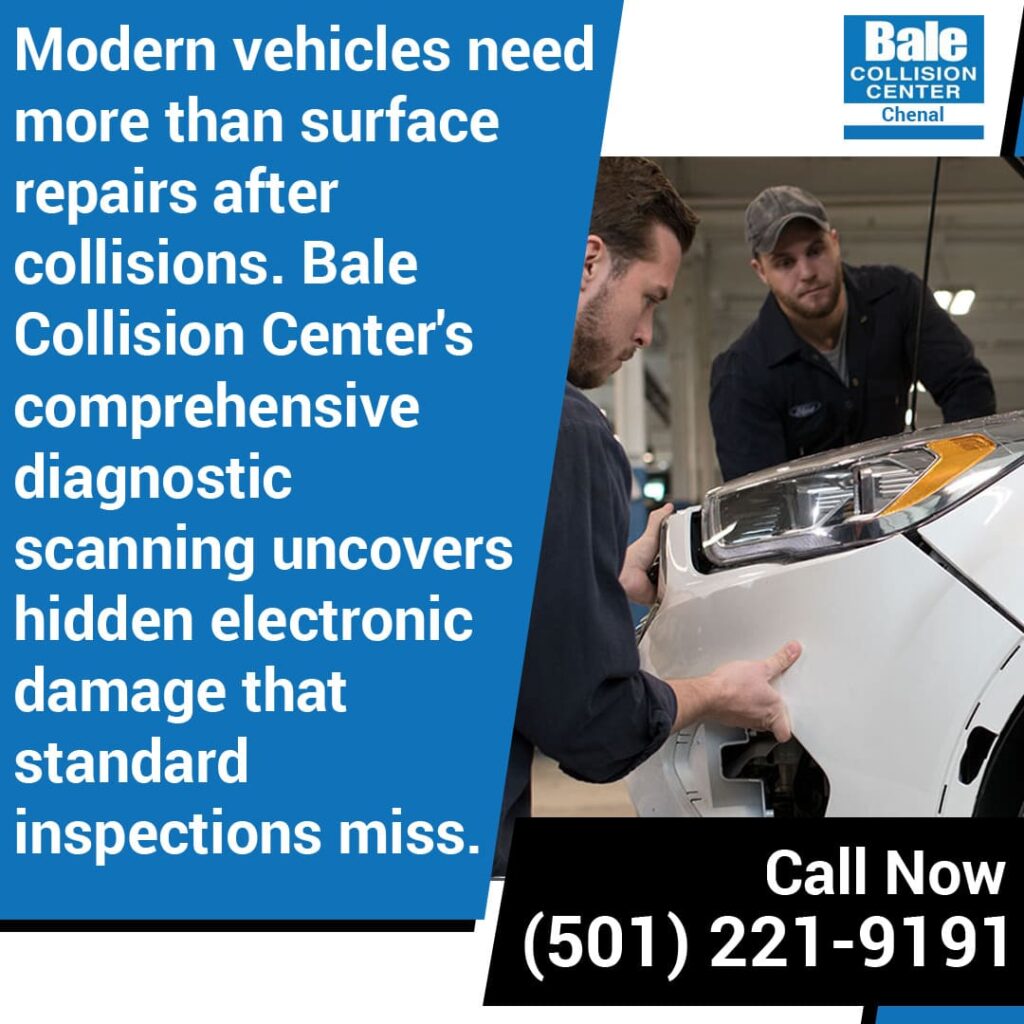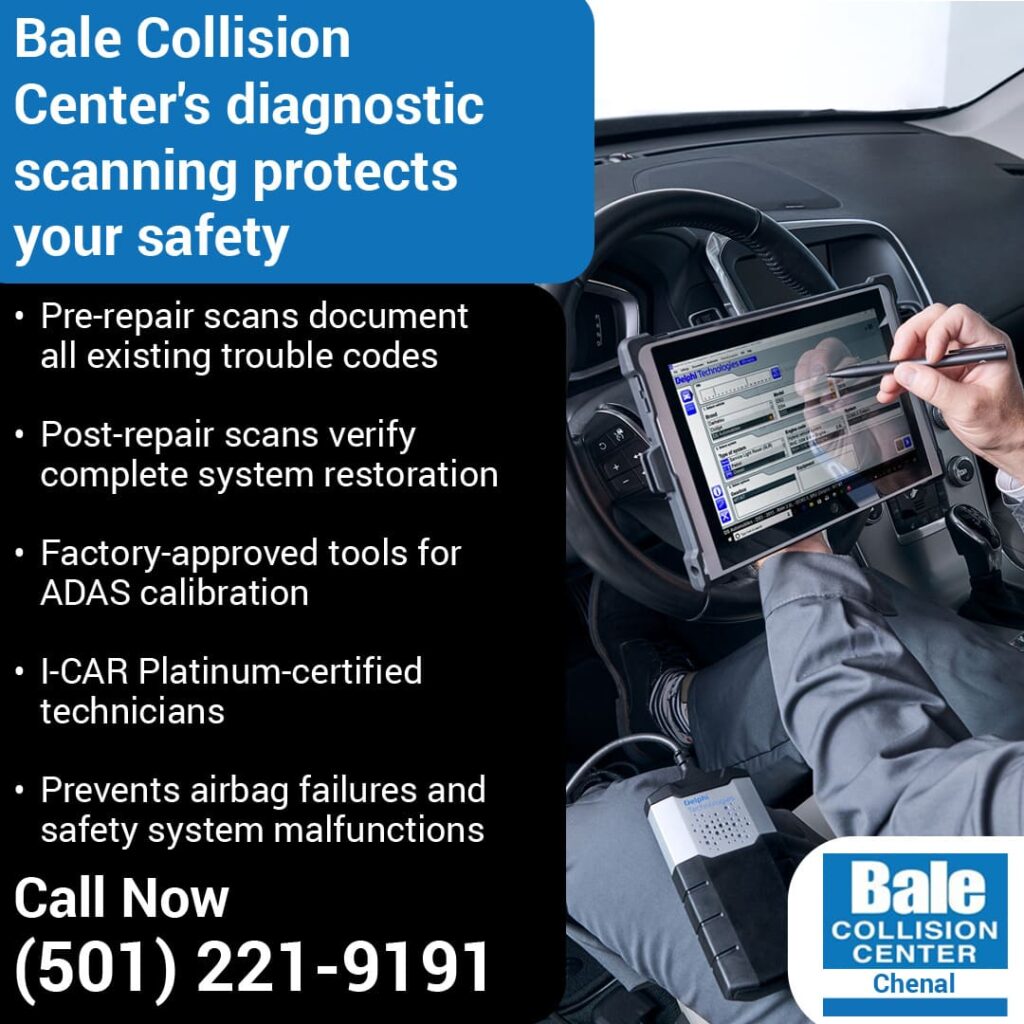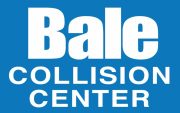Your car just survived a collision. The body shop quotes you a price for fixing the dented fender and repainting the scratched door. Everything seems straightforward until you drive away three weeks later and notice your lane departure warning flashing randomly, or worse, your check engine light comes on during your morning commute. What went wrong?
The answer lies beneath the surface. Today’s vehicles are rolling computers with more lines of code than a fighter jet. A seemingly minor fender bender can trigger a cascade of electronic failures that remain invisible until they compromise your safety or strand you on the side of the road. The radar sensor behind your cracked bumper, the airbag controller mounted near the impact zone, and the dozens of wiring harnesses running through damaged panels are all vulnerable, all critical, and all impossible to verify without proper diagnostic scanning.
At Bale Collision Center (Chenal), our collision repair process treats every vehicle like the sophisticated machine it is. With over 70 years of experience serving Little Rock drivers, we have watched cars evolve from purely mechanical devices into complex electronic systems that require specialized diagnostic attention after every collision. We scan every vehicle twice, before repairs begin and after completion, because we know that protecting your safety means verifying what you cannot see.

Hidden Electronic Damage from Collisions
Accidents damage more than body panels and paint. Modern cars have electronic control systems throughout the vehicle that control safety features, engine performance, and comfort systems.
Impact Forces Break Electronic Parts
Collision impacts travel through your vehicle’s structure. These forces reach the control modules and sensors located throughout the car, not just in the area where you see dents and scratches. The energy from impact can crack circuit boards, disconnect wiring, and shift sensitive components out of position.
A side impact might damage the door control module or seat occupancy sensors even when the door panel looks intact from the outside. A rear-end collision transfers force forward through the vehicle, potentially damaging parking assist sensors, backup camera modules, and trunk-mounted control units despite only showing bumper damage.
For example, a front-end collision bends the bumper and crushes the grille, but the real problem lies behind these visible parts. The radar sensor that controls automatic emergency braking sits directly behind the front grille. Impact forces can crack the sensor housing or misalign the internal antenna without any external signs. The broken sensor remains completely hidden until diagnostic testing reveals the fault.
Electrical Problems from the Crash
The sudden stop during a crash sends voltage spikes through your car’s electrical system. These spikes can damage sensitive electronic parts without leaving marks you can see. Control modules contain small circuits that fail after exposure to the wrong voltage levels.
Battery disconnection during towing can also create problems. Many cars need specific steps to safely disconnect the battery. Collision repair shops that skip these steps cause additional electronic damage during the repair itself.
Sensors Move Out of Position
Crash forces shift sensors and cameras from their correct positions. A sensor moved by a few millimeters gives wrong information to safety systems. Lane departure cameras, blind spot sensors, and parking sensors all need exact positioning to work properly. Even small adjustment problems create real safety risks when these systems fail to work as designed.
Systems That Need Checking After Collision Repairs
A car has three main types of electronic systems that need testing after auto collision repair.
Safety and Driver Assist Features
ADAS (Advanced Driver Assistance Systems) help you avoid accidents. These include automatic braking, lane keeping, and blind spot warning. The systems use cameras and sensors mounted around your vehicle.
A collision can damage these cameras and sensors without triggering dashboard warning lights. A radar sensor with paint on it might work sometimes, but it fails to detect pedestrians. Cameras that shift position give false warnings or stop working when needed most.
At our collision center in Chenal Parkway, Little Rock, we provide complete ADAS calibration services to restore these systems to factory specifications. This specialized work requires factory-approved equipment and trained technicians, which explains why many shops cannot offer proper ADAS calibration.
Airbag Systems
Crash sensors in the car are located throughout the body structure. These sensors measure impact and decide whether to deploy airbags. Even small accidents can damage these sensors.
Diagnostic scans find damaged sensors and communication problems. Without scanning, broken sensors stay in place and create false security.
Engine and Transmission Control Modules
Collisions can disrupt the control modules that manage your engine and transmission without causing mechanical damage. Wiring harnesses, sensor connections, and communication cables can break or come loose during an impact.
Trouble codes are stored in these modules when crashes damage electrical connections. Some codes mean minor issues, like a loose connector. Others indicate damaged wiring that needs replacement before your car runs properly.
A car with front damage might show transmission codes because the crash damaged a wiring harness. You cannot see this wire damage by looking at the engine, but diagnostic scans find the communication problem immediately.
How the Scanning Process Works
Professional car collision repair includes two scans: one before work starts and one after completion.
Before Repairs Begin
The first scan documents what problems exist before any work begins. This protects both you and the repair shop. It shows which problems came from the accident and which existed before.
Technicians connect diagnostic equipment to your car’s diagnostic ports. Modern vehicles are equipped with multiple electronic control modules throughout the vehicle, with luxury and fully-equipped models containing the most. The scan checks each module for stored problems and records the results. The collision repair shop saves screenshots and reports that become part of your repair file.
After Repairs Complete
The second scan confirms that auto collision repairs fixed all the problems. This happens after body work, parts installation, and sensor adjustments. Technicians verify that no new problems have appeared during repairs.
Sometimes the final scan finds issues that need more work. A new control module might need software updates, or a repaired wire might have loose connections. Finding these before you pick up your car prevents headaches later.
Comparing Both Scans
Looking at both scans together reveals damage that only shows up during the repair process. Impact damage sometimes affects parts far from the visible crash area. Repair work can also disturb wires or control modules in nearby areas.
For example, replacing a fender might mean disconnecting door wiring. If technicians damage a connector, the final scan catches the new problem. Without that scan, you would leave with broken power windows or door locks.
What Happens Without Proper Scanning
Cars repaired without diagnostic scans may develop problems weeks or months later.
Problems That Come and Go
Many electronic problems appear randomly instead of all the time. A damaged control module might work fine most days but fail in hot weather. A loose wire might work on smooth roads but disconnect on bumpy ones.
Without scanning, these random problems stay hidden until they become permanent. You get warning lights, system shutdowns, or safety features that stop working. Finding these problems later requires more time and money than catching them during the original auto collision repair.
Safety Features That Fail When Needed
The worst result happens when safety systems fail during the next accident. Airbags that do not deploy or automatic braking that does not activate can turn survivable crashes into tragedies. Legal cases have documented situations where collision-repaired vehicles experienced airbag deployment failures in subsequent accidents, resulting in serious injuries. Investigations revealed that original repair facilities never performed post-collision diagnostic scans, leaving damaged sensors in place.
Lower Resale Value
Cars with unresolved electronic problems show fault codes during inspections or trade-in evaluations. These codes lower your car’s value and raise questions about repair quality. Vehicle history reports now include information about system faults. Buyers who see these reports wonder if your car was fixed correctly. This lowers resale value and makes selling harder.
What Professional Scanning Includes
Good diagnostic work examines every electronic control system in your vehicle and creates detailed reports.
Complete System Check
Professional diagnostic equipment communicates with every control module in your vehicle. This includes body control modules, climate control systems, infotainment modules, and safety system controllers.
Each control module maintains its own set of diagnostic trouble codes. The body control module tracks issues related to lighting circuits and window operations. The safety system module monitors cameras, sensors, and collision avoidance features.
Technicians require manufacturer-specific diagnostic software to access all control modules and interpret codes accurately. Generic code readers lack the capability to communicate with proprietary systems found in modern vehicles.
Operating Condition Records
When control modules detect faults, they store freeze frame data, capturing the vehicle’s operating conditions at the moment the issue occurred. This includes vehicle speed, engine RPM, coolant temperature, and other parameters that assist in accurate diagnosis.
Technicians analyze this stored information to identify problem patterns and determine root causes. A fault occurring exclusively at highway speeds indicates different underlying issues than one appearing only during low-speed maneuvers.
Our Approach at Bale Collision Center
Our collision center in Chenal Parkway, Little Rock, takes diagnostic scanning seriously because your safety depends on it.
Professional Equipment and Training
We maintain diagnostic equipment that meets factory standards. This includes manufacturer scan tools and specialized diagnostic systems for hybrid and electric vehicles. We provide complete ADAS calibration services to restore advanced safety systems to manufacturer specifications. Our technicians hold I-CAR Platinum certifications, the highest training level in collision repair. This training covers electronic diagnostics, proper scan tool operation, and an understanding of advanced safety systems to coordinate complete repairs.
Clear Communication
We give you copies of scan reports with your repair paperwork. These reports show what problems existed before repairs, what we fixed, and confirmation that systems work correctly now. When the final scan finds issues beyond the original estimate, we call you to discuss what we found. This prevents surprises when you return for pickup.
Working With Insurance Companies
We work with all insurance companies to get approval for diagnostic scanning. Our relationships with adjusters at State Farm, Allstate, Liberty Mutual, USAA, and Nationwide help speed up the approval process. When adjusters question why scanning is needed, we provide factory documentation showing that modern cars require this testing after car collision repair.

Protect Your Safety After a Collision
Every car accident requires professional diagnostic attention, no matter how small the damage looks. The safety systems protecting your family depend on sensors and control modules that you cannot check by looking at them.
Choosing a car collision repair in Chenal, Little Rock, AR, that includes proper scanning protects your safety and prevents expensive problems later. At Bale Collision Center, our 70 years in business reflect our commitment to doing repairs the right way.
Do not accept auto collision repair that skips diagnostic scanning. Your car’s electronics need attention from trained technicians with proper equipment. Contact Bale Collision Center, your trusted collision center in Chenal Parkway, Little Rock, at (501) 221-9191 or email bccwlr@baleautomotive.com to schedule your repair with complete diagnostic testing included.
